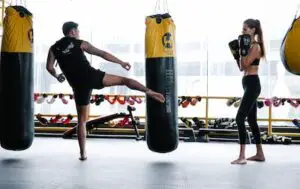In the vast world of martial arts, two prominent disciplines, Krav Maga and Judo, have garnered widespread recognition for their effectiveness and practicality. While both martial arts share certain similarities, understanding their differences is crucial in determining which one aligns better with your goals and preferences. In this article, we will explore the contrasting aspects of Krav Maga and Judo, delving into their origins, techniques, training methods, competitive aspects, and belt ranking systems.
Origin and History
How did Krav Maga originate and evolve over time? Krav Maga, developed in the 1930s, traces its roots to Imi Lichtenfeld’s street-fighting experiences in Bratislava. Over time, it evolved into a practical self-defense system that integrated techniques from various martial arts.
What is the historical background of Judo and how has it evolved? Judo, founded by Jigoro Kano in the late 19th century, emerged as a modern martial art from traditional Japanese jujutsu. Kano’s vision was to create a system that emphasized mutual respect, discipline, and personal development.
Philosophical and Cultural Influences
How are the philosophical principles and cultural influences distinct in Krav Maga? Krav Maga, primarily focused on self-defense, emphasizes practicality and efficiency. It draws inspiration from military combat techniques and prioritizes neutralizing threats quickly and effectively.
What philosophical and cultural influences are prominent in Judo? Judo embodies the principles of maximum efficiency and mutual welfare. It emphasizes the concept of using an opponent’s strength against them and places great emphasis on discipline, respect, and personal growth.
Techniques and Focus
How do the techniques in Krav Maga differ from those in Judo? Krav Maga techniques encompass a wide range of strikes, kicks, punches, and defenses against armed and unarmed assailants. It incorporates elements of boxing, Muay Thai, and wrestling, focusing on practical real-world scenarios.
Which martial art emphasizes striking and self-defense techniques? Krav Maga places significant emphasis on striking techniques and practical self-defense strategies. Its primary objective is to neutralize threats quickly and escape dangerous situations.
How does Judo focus on throws, grappling, and ground fighting? Judo is renowned for its dynamic throws, takedowns, and ground fighting techniques. It emphasizes using an opponent’s momentum and leverage to gain control and execute precise techniques.
Training Methods and Practices
What are the training methods employed in Krav Maga? Krav Maga training involves realistic scenarios, stress drills, and simulations of high-pressure situations. It aims to prepare practitioners mentally and physically to respond effectively in dangerous encounters.
How does Judo training differ in terms of structure and practices? Judo training typically involves practicing throws, grappling techniques, and ground fighting in a controlled environment. It emphasizes progressive resistance training and focuses on precise execution of techniques.
Which martial art emphasizes practicality and real-life scenarios? Both Krav Maga and Judo have practical applications, but Krav Maga places more emphasis on real-life scenarios and self-defense in unpredictable situations, while Judo’s training environment is more structured and focused on sportive applications.
Competitive Aspects
How are Krav Maga competitions structured, if any? Krav Maga, primarily designed for self-defense, does not have a standardized competitive format. However, some organizations conduct controlled scenarios and skill-based competitions to showcase practitioners’ abilities.
What are the competitive formats and rules followed in Judo? Judo has a well-established competitive structure, including randori (sparring), shiai (tournament matches), and kata (prearranged forms). It follows a set of rules that regulate techniques, grips, and scoring criteria.
Belt Ranking Systems
How does Krav Maga evaluate and recognize progression? Krav Maga does not have a standardized belt ranking system. Instead, it often employs a patch system or utilizes levels to denote practitioner progression and expertise.
What are the different belt ranking systems used in Judo? Judo employs a belt ranking system with various colored belts, starting from white (beginner) and progressing through different degrees of brown and black belts. Each belt signifies the practitioner’s level of skill and knowledge.
Conclusion
Understanding the differences between Krav Maga and Judo is essential in choosing the martial art that suits your goals, preferences, and lifestyle. Krav Maga emphasizes practical self-defense techniques, while Judo focuses on throws, grappling, and ground fighting. Krav Maga training involves realistic scenarios and stress drills, while Judo training follows a more structured environment with progressive resistance.
Ultimately, the decision between Krav Maga and Judo should be based on your desired outcomes. If you seek self-defense skills applicable to real-life situations, Krav Maga might be the right choice. Alternatively, if you are drawn to the artistry of throws, grappling, and a structured competitive environment, Judo could be the perfect fit.
Remember to consult with experienced instructors, visit local dojos or training centers, and try out classes to gain firsthand experience and make an informed decision. Both Krav Maga and Judo offer valuable physical and mental benefits, so explore the unique characteristics of each art and embark on a martial arts journey that aligns with your aspirations.





